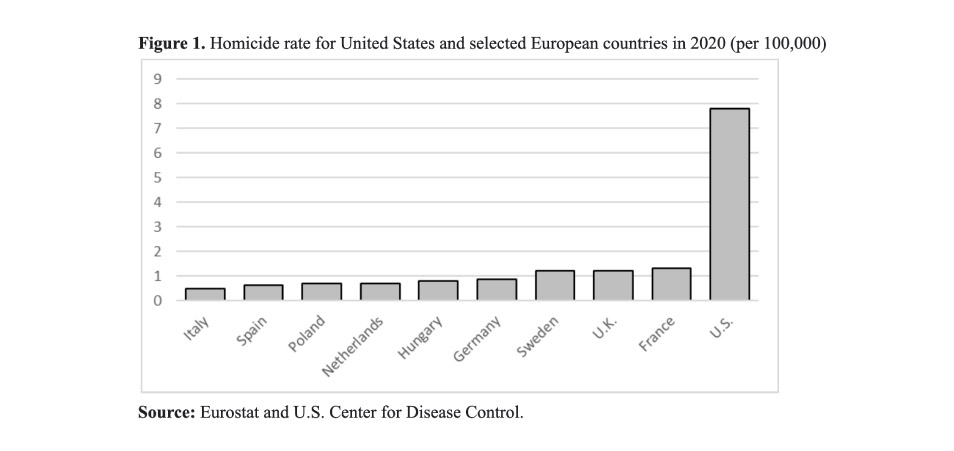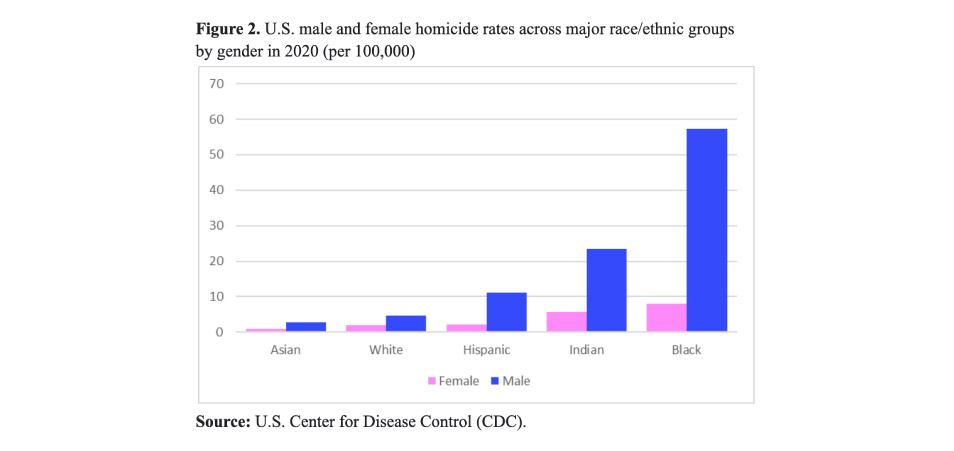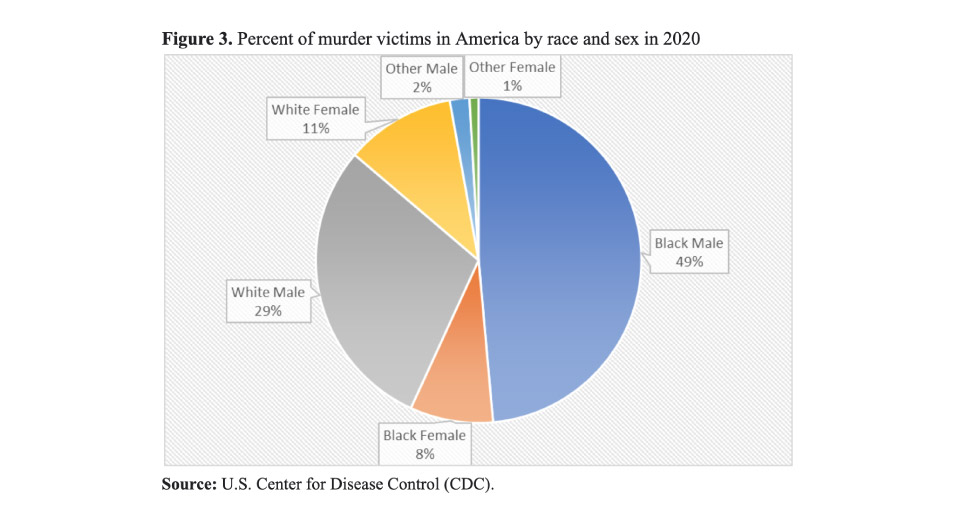
America leads advanced developed countries in terms of guns per capita and homicide rates, although with substantial variation by state, gender, and major racial/ethnic groups. Given its policies on police, guns and homicides, Joseph Chamie opines, America’s homicide rate is unlikely to reach low levels any time soon.
Introduction
Among advanced developed countries, the United States has the highest homicide rate: 7.8 per 100,000 population in 2020. Most others, including Germany, France, Italy, Japan, Spain and the United Kingdom, have homicide rates that are a fraction of this level (Figure 1). For example, the U.S. firearm homicide rate in 2019 was 22 times greater than the rate of the European Union.

сравнивать имеет смысл с Швейцарией, или Израилем :(
U.S. homicide rates
The U.S. homicide rate of 7.8 per 100,000 in 2020 is the highest since 1995 and represents a record increase of approximately 30 percent with respect to 2019. Possible explanations for this rise include the consequences of the COVID pandemic and the worsening relations between police and communities following the murder of George Floyd (25 May 2020). Often heard political explanations for the rise, such as “some are soft on crime”, are not supported by the data. Homicide rates have increased in both Democratic and Republican states, in cities controlled by Republican and Democratic mayors, and in the suburbs and rural areas.
Of the 139 mass shootings that occurred in developed countries between 1998 to 2019, 73 percent occurred in the United States and resulted in 816 deaths. France had the next highest number of mass shootings with 8, resulting in 179 deaths, including the Bataclan terrorist attack of November 2015 (90 deaths). America’s 2020 homicide rate, however, remains markedly lower than the rates in the 1970s and 1980s. Forty years ago, for example, the U.S. rate exceeded 10 homicides per 100,000.
Homicide rates vary considerably across America’s 50 states. The highest are typically found in the south. For example, the three states with the highest rates in 2020 were Mississippi, Louisiana and Alabama (21, 20 and 14 per 100,000 population, respectively). However, in 2020, Washington D.C. had an even higher homicide rate of approximately 25 murders per 100,000 residents.
In contrast, the lowest homicide rates are observed in northeastern states. The three states with the lowest rates are Maine, New Hampshire and Vermont (below 2 per 100,000).
Approximately 80 percent of U.S. homicides in 2020 involved firearms, most often handguns. In the 1960s, by contrast, handguns were used in approximately 50 percent of homicides.
In terms of gun ownership, America is by far the world leader, at 120 guns per 100 population, with about 40 percent of Americans owning firearms. This is well above the proportions of the next four highest countries, i.e., Yemen at 53, Serbia and Montenegro at 39 and Canada at 35.
A noteworthy feature of homicide rates across America is that the male rate (12.8 per 100,000 in 2020) is many times higher than the female rate (2.9 per 100,000). This translates into approximately 80 percent of homicide victims being males.
Over the years, various proposals and strategies have been recommended to address America’s high rate of homicides. Many emphasize the need for social and economic investments, long-term strategies and anti-crime measures focusing on education, jobs, housing, inequality, racism, outreach programs, drug treatment and gun control.
Those investments require economic and social resources as well as political backing and it typically takes time for results to become visible. Faced with the rising number of homicides, and the high homicide rate, relatively few people are prepared to wait.
Approximately 80 percent of U.S. homicides in 2020 involved firearms, most often handguns. In the 1960s, by contrast, handguns were used in approximately 50 percent of homicides.
In terms of gun ownership, America is by far the world leader, at 120 guns per 100 population, with about 40 percent of Americans owning firearms. This is well above the proportions of the next four highest countries, i.e., Yemen at 53, Serbia and Montenegro at 39 and Canada at 35.
Homicide differentials
A noteworthy feature of homicide rates across America is that the male rate (12.8 per 100,000 in 2020) is many times higher than the female rate (2.9 per 100,000). This translates into approximately 80 percent of homicide victims being males.
Homicides rates also vary markedly by age. They increase through the teenage years and peak in the early twenties. As in recent years, gun homicide in 2020 was the leading cause of death among the under-25s, and people under age 30 were nearly 10 times more likely to die from a firearm than from COVID-19.
In addition to significant differences by age and sex, wide gaps in homicide rates exist among America’s five major racial/ethnic groups as defined by the U.S. Census Bureau.
In 2020 the homicide rates for Black American males and females were the highest among the five groups, at 57 and 8 per 100,000, respectively. They were followed by Indian American males and females (24 and 6 per 100,000), Hispanic American males and females (11 and 2 per 100,000), and White American males and females (5 and 2 per 100,000). The lowest homicide rates were among Asian American males and females, at 3 and 1 per 100,000 (Figure 2).
Those differences in homicide rates produce a striking distribution in the numbers of homicide victims among the groups. Black males accounted for 49 percent of homicide victims in 2020, followed by White males at 29 percent, White females at 11 percent, and Black females at 8 percent (Figure 3).
In 2018 homicide was the fifth leading cause of death among Black males, and the ninth leading cause among Hispanic and American Indian males.
In 2020 the homicide rates for Black American males and females were the highest among the five groups, at 57 and 8 per 100,000, respectively. They were followed by Indian American males and females (24 and 6 per 100,000), Hispanic American males and females (11 and 2 per 100,000), and White American males and females (5 and 2 per 100,000). The lowest homicide rates were among Asian American males and females, at 3 and 1 per 100,000 (Figure 2).

Those differences in homicide rates produce a striking distribution in the numbers of homicide victims among the groups. Black males accounted for 49 percent of homicide victims in 2020, followed by White males at 29 percent, White females at 11 percent, and Black females at 8 percent (Figure 3).

In 2018 homicide was the fifth leading cause of death among Black males, and the ninth leading cause among Hispanic and American Indian males.
Addressing homicide rates
Over the years, various proposals and strategies have been recommended to address America’s high rate of homicides. Many emphasize the need for social and economic investments, long-term strategies and anti-crime measures focusing on education, jobs, housing, inequality, racism, outreach programs, drug treatment and gun control.
Those investments require economic and social resources as well as political backing and it typically takes time for results to become visible. Faced with the rising number of homicides, and the high homicide rate, relatively few people are prepared to wait.
A growing share of Americans − now at nearly half − want more spending on police in their neighborhoods to address violent crime. But increased police funding has also become a partisan issue. While 61 percent of Republicans believe spending on police should be increased, only about one-third of Democrats share that view.
Given the current state of affairs in the country with respect to police, guns and homicides, America’s high homicide rate is unlikely to decline any time soon to the low levels enjoyed by other advanced developed countries.
References
- Ax, Joseph (2022) “Analysis: Crime is a top concern for many Americans in midterm vote. How bad is it?”. Reuters, 1 November.
- BBC News (2022) “Mass shootings: America’s challenge for gun control explained in seven charts”. 12 October.
- Beckett, Lois and Abene Clayton (2022) “An unspoken epidemic’: Homicide rate increase for Black women rivals that of Black men”. The Guardian, 25 June.
- Claudio, Andre (2021) “States With the Highest Homicide Rates”. Route Fifty, 30 November.
- Cooper, Alexia and Erica L. Smith (2011) “Homicide Trends in the United States, 1980-2008”. U.S. Department of Justice, Bureau of Justice Statistics, November.
- Council on Criminal Justice (2022) “Saving Lives: Ten Essential Actions Cities Can Take to Reduce Violence Now”. 12 January.
- Eurostat (2022) “Crime Statistics”. Eurostat Statistics Explained. Luxembourg.
- Murez, Cara (2022) “Gun Homicides Rose Sharply During Pandemic, Black Men Most Affected”. US News, 15 December.
- Parker, Kim and Kiley Hurst (2021) “Growing share of Americans say they want more spending on police in their area”. Pew Research Center, 26 October.
- Silva, Jason R. (2022) “Global mass shootings: comparing the United States against developed and developing countries”. International Journal of Comparative and Applied Criminal Justice, 21 March.
- U.S. Center for Disease Control (2022) “Leading Causes of Death – Males and Females – United States, 2018”. Centers for Disease Control and Prevention, 3 March.
- U.S. Center for Disease Control (2021) “New CDC/NCHS Data Confirm Largest One-Year Increase in U.S. Homicide Rate in 2020”. Centers for Disease Control and Prevention, 6 October.
No comments:
Post a Comment